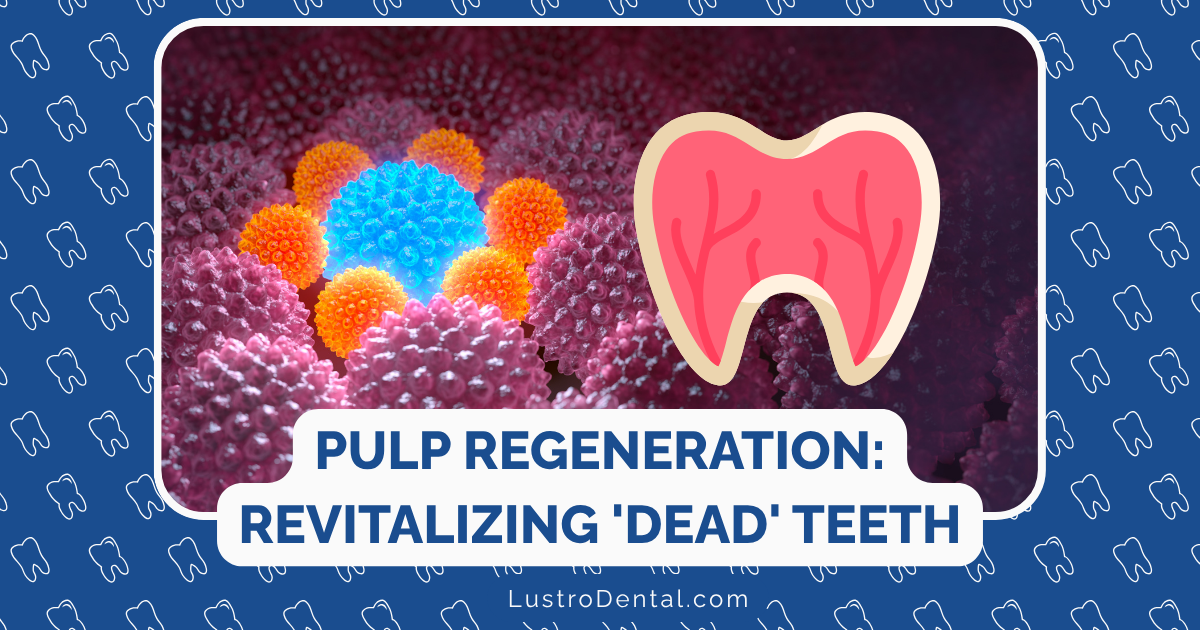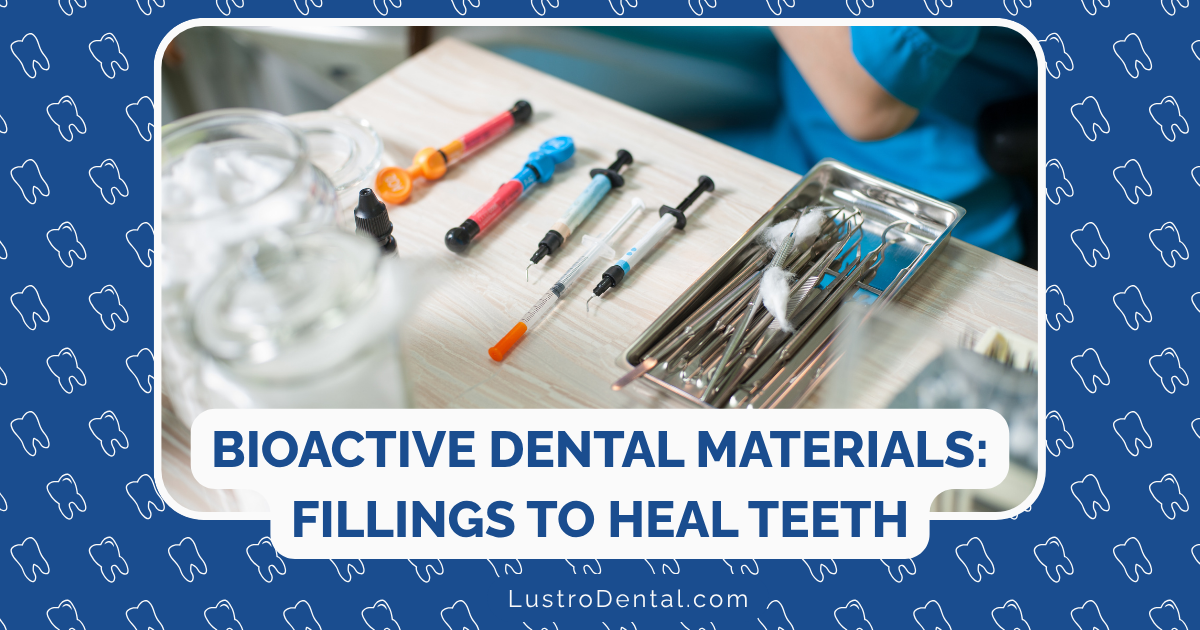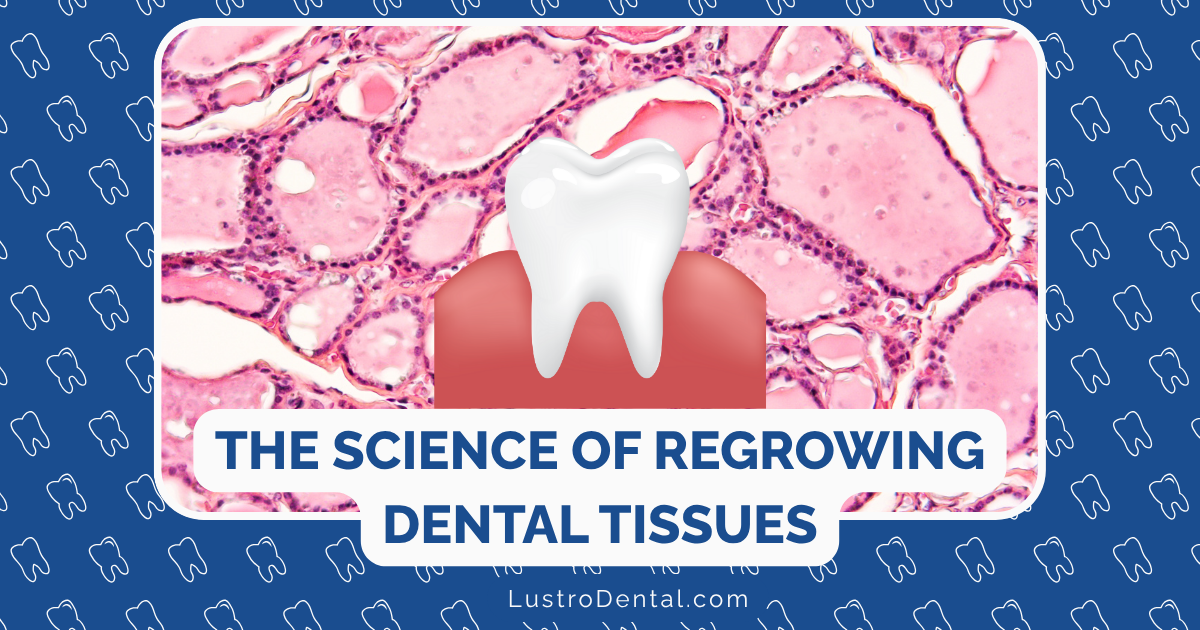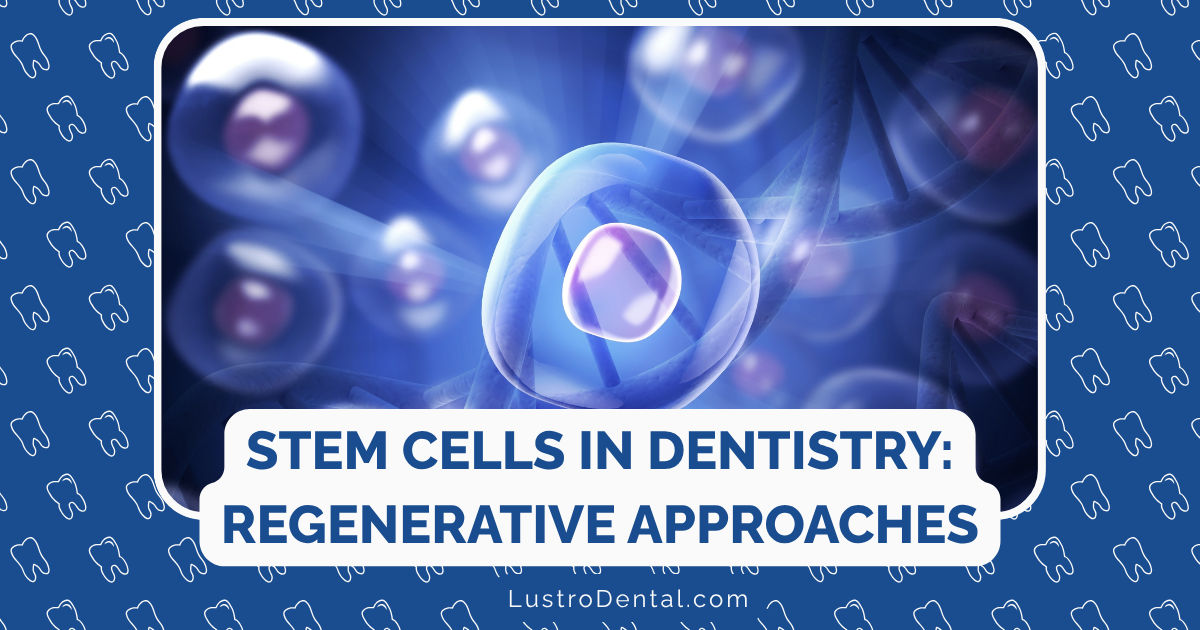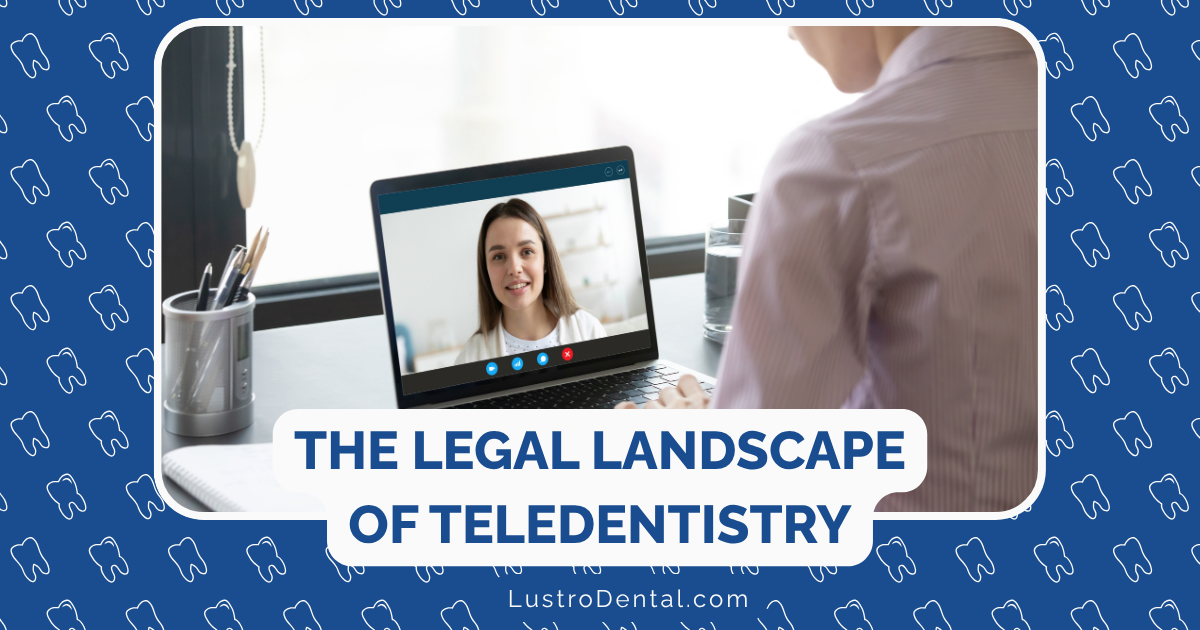The Future of Tooth Replacement: Growing vs. Replacing Teeth
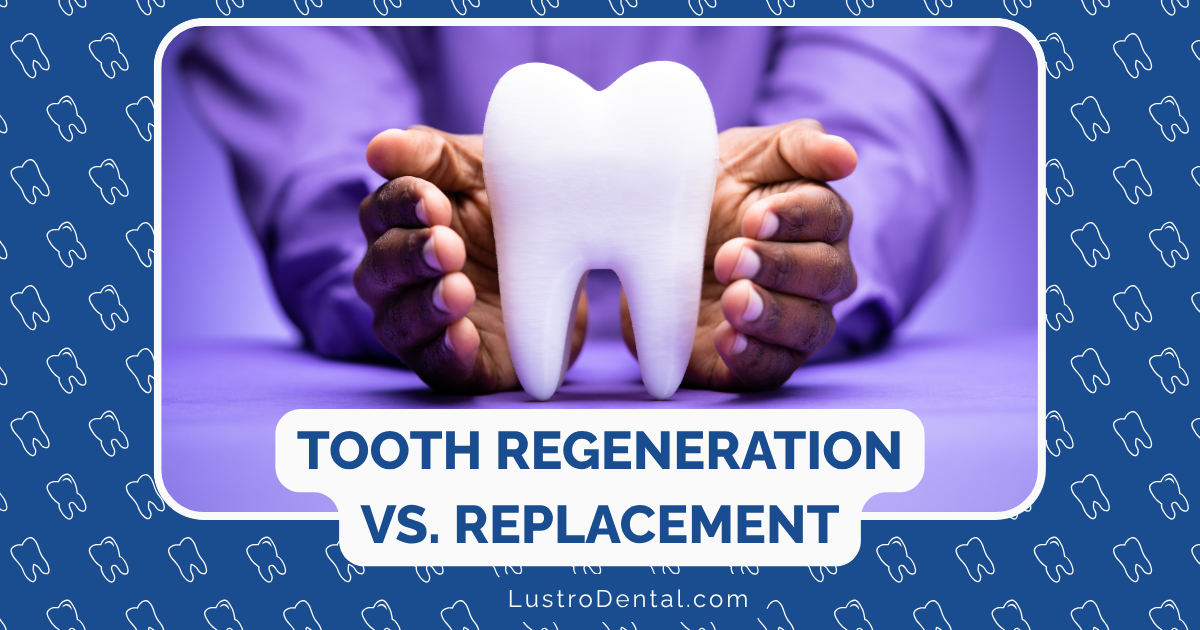
Tooth loss is a universal health challenge that has plagued humanity throughout history. According to research published in PMC, approximately two out of three Americans have one or more missing teeth, and over 50% of individuals aged 70 or older have lost all their natural teeth. Globally, the prevalence of complete tooth loss is 7% among those aged 20 and over, rising dramatically to 23% for those over 60, as reported by Dentistry.co.uk.
For centuries, our approach to tooth loss has been replacement rather than regeneration—using artificial substitutes like dentures, bridges, and more recently, dental implants. But a revolution is brewing in dental medicine that may fundamentally change how we address missing teeth. Rather than replacing teeth with artificial substitutes, what if we could regrow them? This isn’t science fiction—it’s the emerging field of tooth regeneration, and it promises to transform dental care as we know it.
Let’s explore the current state of tooth replacement, the exciting advances in tooth regeneration, and how these approaches compare in what may be one of the most significant shifts in dental medicine since the advent of implants.
The Current Standard: Artificial Tooth Replacement
Before diving into future possibilities, it’s important to understand our current approaches to tooth replacement and their limitations.
Dental Implants: The Gold Standard Today
Dental implants have revolutionized tooth replacement since their widespread adoption in the 1980s. These titanium posts surgically placed in the jawbone serve as artificial tooth roots, supporting crowns, bridges, or dentures.
Advantages:
- High success rates (95-98% over 10 years)
- Prevent bone loss in the jaw
- Look and function similarly to natural teeth
- Can last decades with proper care
Limitations:
- Require invasive surgery
- Lack a periodontal ligament, which affects sensory feedback and shock absorption
- Can lead to bone resorption over time due to direct transmission of chewing forces
- Not suitable for all patients, particularly those with insufficient bone or certain medical conditions
- Expensive, with costs ranging from $3,000-$6,000 per implant according to Oradent Dental Clinic
Dr. Sarah Johnson, a prosthodontist specializing in implant dentistry, explains: “Dental implants have transformed our ability to replace missing teeth, but they’re still fundamentally artificial substitutes. They don’t adapt or respond to the body’s changing needs like natural teeth do, and they lack the biological integration of a natural tooth with its periodontal ligament.”
Bridges and Dentures: Traditional Approaches
Traditional options like bridges and dentures remain common, particularly for patients who cannot receive implants or seek more affordable options.
Advantages:
- Less invasive than implants
- Lower initial cost
- No surgery required
- Suitable for more patients
Limitations:
- Reduced chewing efficiency
- Potential damage to adjacent teeth (for bridges)
- Accelerated bone loss in the jaw (particularly with dentures)
- Shorter lifespan than implants
- Require more maintenance and eventual replacement
The Fundamental Limitation: Artificial vs. Biological
All current tooth replacement options share one fundamental limitation: they are artificial substitutes rather than biological replacements. This distinction is crucial because artificial replacements:
- Do not adapt to changes in the oral environment
- Cannot repair themselves when damaged
- Lack the sensory feedback of natural teeth
- Do not maintain the living bone and tissue connections of natural teeth
This is where the promise of regenerative approaches comes in—the possibility of growing rather than replacing teeth.
The Regenerative Revolution: Growing New Teeth
The field of regenerative dentistry aims to harness the body’s own capacity for growth and healing to restore lost dental tissues and, ultimately, entire teeth. Several promising approaches are under development:
Bioengineered Whole Teeth: Creating Teeth in the Lab
One of the most exciting approaches involves growing complete teeth in laboratory settings using combinations of dental stem cells and scaffolds.
In February 2025, researchers at Tufts University achieved a significant breakthrough, as reported by Dentistry.co.uk. They successfully grew human-like replacement teeth in a lab and implanted them into the jaws of miniature pigs. The team, led by Dr. Pamela Yelick, combined human and porcine tooth cells to create tooth-like structures that, when implanted, developed hard layers of dentin and cementum.
A study published in Stem Cells Translational Medicine in February 2025 described this groundbreaking approach:
- Scientists created bioengineered tooth buds using decellularized tooth bud extracellular matrix scaffolds
- These scaffolds were seeded with human dental pulp cells, porcine tooth bud-derived dental epithelial cells, and human umbilical vein endothelial cells
- The constructs were implanted in the mandibles of adult Yucatan minipigs
- After 2-4 months, they had formed tooth-like tissues, including periodontal ligament tissues
Dr. Michael Chen, a researcher involved in similar studies, explains: “What makes this approach so promising is that we’re not just creating a tooth-shaped object—we’re recreating the developmental process that forms a tooth naturally. The result is a structure with the complex, integrated tissues of a natural tooth, including the crucial periodontal ligament that connects the tooth to bone.”
Stimulating Natural Tooth Regrowth: Awakening Dormant Capabilities
Another fascinating approach focuses on stimulating the body’s own tooth-forming capabilities, which normally shut down after our permanent teeth develop.
Researchers at the Medical Research Institute Kitano Hospital in Osaka have developed a tooth regrowth medicine using RNA to block the USAG-1 molecule, which inhibits tooth development. According to Dentistry.co.uk, initial animal trials showed success in promoting the growth of new teeth in mice, ferrets, and dogs. Human trials began in October 2024, targeting healthy adults with missing teeth, with the medicine expected to be ready for general use by 2030 if trials are successful.
This approach is particularly exciting because it:
- Requires no surgery
- Uses the body’s own developmental pathways
- Could potentially be administered as a simple medication
- Might allow for the growth of teeth in their natural positions
Partial Regeneration: Regrowing Components of Teeth
While whole tooth regeneration represents the ultimate goal, significant progress has also been made in regenerating individual components of teeth:
Dental Pulp Regeneration
Clinical trials have demonstrated successful regeneration of dental pulp—the living tissue inside teeth—using dental stem cells.
Research published in PMC described a clinical trial where 26 teeth from 26 patients received autologous stem cells from human exfoliated deciduous teeth (SHED), leading to highly vascularized dental pulp regeneration. This approach could transform root canal therapy, potentially allowing “dead” teeth to become vital again.
Enamel Regeneration
Researchers have developed methods to regenerate enamel, the hardest substance in the human body and one that doesn’t naturally regenerate.
A gel developed in 2019 can create a three-micrometer-thick layer of new enamel in just 48 hours when applied to damaged tooth samples. According to Dentistry.co.uk, this repair is considered permanent and uses inexpensive materials that can be prepared on a large scale.
Periodontal Tissue Regeneration
Several clinical trials using periodontal ligament stem cells (PDLSCs) for tissue regeneration are ongoing worldwide, as noted in PMC. These trials aim to regenerate the complex tissues that connect teeth to bone, potentially saving teeth that would otherwise be lost to periodontal disease.
Comparing Approaches: Growing vs. Replacing
As regenerative approaches move closer to clinical reality, how do they compare to traditional tooth replacement methods? Let’s examine the potential advantages and challenges of each approach:
Potential Advantages of Regenerated Teeth
Biological Integration: Regenerated teeth would have a periodontal ligament, providing natural sensory feedback and shock absorption that implants lack.
Self-Repair Capability: Like natural teeth, regenerated teeth would contain living cells capable of responding to injuries and repairing minor damage.
Natural Development: Regenerated teeth could potentially continue root development and adapt to the jaw over time, particularly important for younger patients.
Longevity: While high-quality dental implants can last decades, a successfully regenerated tooth could theoretically last a lifetime with proper care.
Bone Preservation: The natural connection between a regenerated tooth and jawbone would help maintain bone volume and density through normal physiological processes.
Dr. Lisa Rodriguez, a specialist in regenerative dentistry, notes: “The most significant advantage of a regenerated tooth would be its biological nature. It wouldn’t just be a replacement—it would be a living part of the body, integrated with the surrounding tissues and responsive to the oral environment in ways no artificial replacement could match.”
Challenges and Limitations of Regenerative Approaches
Despite their promise, regenerative approaches face several significant challenges:
Time Factor: Growing teeth takes time—in nature, teeth develop over months to years. This presents practical challenges for patients needing immediate replacements.
Predictability: Ensuring that regenerated teeth grow to the right size, shape, and position remains challenging.
Complexity: Teeth are complex organs with multiple specialized tissues, making them more difficult to regenerate than simpler tissues.
Cost and Accessibility: Initial regenerative therapies will likely be expensive and limited to specialized centers before becoming widely available.
Regulatory Hurdles: New biological therapies face rigorous regulatory processes before approval for human use.
The Evolution of Implant Technology
While regenerative approaches develop, dental implant technology continues to advance:
According to Oradent Dental Clinic, next-generation dental implants in 2025 offer several improvements:
- 3D-printed implants custom-fitted based on digital scans ($5,000-$8,500)
- Smart implants with AI monitoring for early detection of problems ($6,500-$10,000)
- Bioengineered implants coated with growth factors to enhance healing
- Metal-free zirconia implants that are hypoallergenic and aesthetically appealing ($4,500-$7,000)
- Minimally invasive same-day implants with faster recovery times
These advances may narrow some of the gaps between artificial and regenerated teeth, particularly in terms of biocompatibility and integration with natural tissues.
The Likely Future: A Spectrum of Options
Rather than an either/or scenario, the future of tooth replacement will likely offer a spectrum of options tailored to individual patient needs, preferences, and clinical situations.
Short-Term Outlook (5-10 Years)
- Advanced Implants: Next-generation implants with improved biocompatibility and integration
- Partial Regeneration: Therapies to regenerate dental pulp and periodontal tissues
- Early Whole Tooth Regeneration: Initial clinical trials for bioengineered teeth in specific cases
Medium-Term Outlook (10-20 Years)
- Medication-Induced Tooth Growth: Treatments that stimulate natural tooth development in simple cases
- Hybrid Approaches: Combinations of artificial and regenerated components
- Expanded Regenerative Options: Bioengineered teeth becoming available for more complex cases
Long-Term Vision (20+ Years)
- On-Demand Tooth Regeneration: Customized tooth regeneration becoming routine
- Preventive Regeneration: Interventions to prevent tooth loss before it occurs
- Whole-Mouth Regeneration: Options for patients with complete tooth loss
Dr. Robert Thompson, a dental futurist who studies emerging technologies, predicts: “We’re not looking at regeneration completely replacing implants, but rather at an expanded toolkit where clinicians can choose the most appropriate solution for each patient. Some patients will benefit most from advanced implants, others from regenerative approaches, and many from combinations of techniques.”
Patient Considerations: What This Means for You
If you’re currently facing decisions about tooth replacement or anticipating future needs, how should these emerging technologies factor into your planning?
If You Need Tooth Replacement Now
- Discuss All Options: Ask your dentist about the latest advances in both implant and regenerative technologies
- Consider Preservation: If appropriate, techniques like socket preservation can maintain bone and tissue for future regenerative options
- Evaluate Longevity: Consider how long you need a solution to last and whether future technologies might offer better options
- Assess Reversibility: Some current replacement options may be more compatible with future regenerative approaches than others
If You’re Planning for Future Needs
- Preventive Focus: The best tooth replacement is avoiding the need in the first place through excellent oral hygiene and preventive care
- Consider Banking: Some companies offer dental stem cell banking from extracted teeth, which might be useful for future regenerative therapies
- Stay Informed: Keep up with advances in both implant technology and regenerative approaches
- Discuss Genetic Factors: If tooth loss runs in your family, discuss genetic considerations with your dentist
James’s Story: A Patient Perspective
James, a 45-year-old who recently lost a molar, shares his decision-making process:
“When my dentist told me I needed to have my molar extracted, I immediately thought about an implant. But after discussing emerging options, I decided on a socket preservation procedure after the extraction to maintain bone volume. This gives me time to see how regenerative options develop over the next few years while keeping my options open. If regenerative approaches aren’t available when I’m ready, I can still get an implant, but I’m hopeful that something better might be available by then.”
Ethical and Practical Considerations
The development of tooth regeneration technologies raises several important considerations:
Ethical Considerations
- Stem Cell Sources: Questions about the ethical sourcing of stem cells for regenerative therapies
- Access and Equity: Concerns about whether advanced therapies will be accessible to all or only to the wealthy
- Informed Consent: Ensuring patients understand the risks and limitations of new technologies
Practical Considerations
- Insurance Coverage: How dental insurance will adapt to cover regenerative treatments
- Provider Training: The need for dentists to develop new skills and knowledge
- Integration with Existing Care: How regenerative approaches will complement rather than replace current techniques
Conclusion: A Transformative Moment in Dental Medicine
The field of tooth replacement stands at a transformative moment. For the first time in human history, we’re moving beyond simply replacing missing teeth with artificial substitutes to the possibility of actually regenerating them. While traditional approaches like implants continue to advance and remain excellent options for many patients, regenerative approaches offer the tantalizing prospect of truly biological replacements.
The global dental implant market was valued at USD 4.6 billion in 2019 and is expected to grow at a CAGR of 9.0%, according to PMC. This substantial industry reflects both the magnitude of the tooth loss problem and the resources available to address it. As regenerative approaches mature, they will likely reshape this landscape, potentially offering solutions that are not just replacements but true regeneration.
For patients, this evolution promises more options, better outcomes, and potentially more natural-feeling and functioning teeth. For dental professionals, it represents both a challenge to stay current with rapidly advancing technology and an opportunity to offer truly transformative care.
The future of tooth replacement isn’t simply about choosing between growing and replacing teeth—it’s about having a spectrum of options that can be tailored to each patient’s unique needs. Whether through advanced implants, bioengineered teeth, or stimulated natural growth, the goal remains the same: restoring not just the appearance but the full function and integration of natural teeth.
Have you had experience with tooth replacement? Are you excited about the possibilities of tooth regeneration? Share your thoughts in the comments below!


